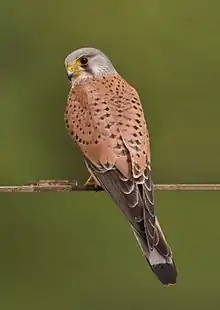Eufalconimorphae
Eufalconimorphae is a proposed clade of birds, consisting of passerines, parrots, falcons, caracaras, and forest falcons (but not other raptors).[3] It has whole-genome DNA support.[4] The Eufalconimorphae is noted to produce aerodynamic force during the upstroke of flight to help create a vertical flight pattern.[5]
| Eufalconimorphae | |
|---|---|
 | |
| Common kestrel, Falco tinnunculus | |
| Scientific classification | |
| Kingdom: | Animalia |
| Phylum: | Chordata |
| Class: | Aves |
| Clade: | Australaves |
| Clade: | Eufalconimorphae Suh et al., 2011 |
| Subclades | |
See below cladogram showing Eufalconimorphae's relationship within Australaves:[4][6]
| Australaves |
| ||||||||||||||||||
References
- Boles, Walter E. (1997). "Fossil songbirds (Passeriformes) from the Early Eocene of Australia". Emu. 97 (1): 43–50. doi:10.1071/MU97004.
- Kuhl., H.; Frankl-Vilches, C.; Bakker, A.; Mayr, G.; Nikolaus, G.; Boerno, S. T.; Klages, S.; Timmermann, B.; Gahr, M. (2020). "An unbiased molecular approach using 3'UTRs resolves the avian family-level tree of life". Molecular Biology and Evolution: 143. doi:10.1093/molbev/msaa191. PMC 7783168.
- Alexander Suh; Martin Paus; Martin Kiefmann; Gennady Churakov; Franziska Anni Franke; Jürgen Brosius; Jan Ole Kriegs; Jürgen Schmitz (2011). "Mesozoic retroposons reveal parrots as the closest living relatives of passerine birds". Nature Communications. 2 (8): 443. Bibcode:2011NatCo...2..443S. doi:10.1038/ncomms1448. PMC 3265382. PMID 21863010.
- Jarvis, E. D.; Mirarab, S.; Aberer, A. J.; Li, B.; Houde, P.; Li, C.; Ho, S. Y. W.; Faircloth, B. C.; Nabholz, B.; Howard, J. T.; Suh, A.; Weber, C. C.; Da Fonseca, R. R.; Li, J.; Zhang, F.; Li, H.; Zhou, L.; Narula, N.; Liu, L.; Ganapathy, G.; Boussau, B.; Bayzid, M. S.; Zavidovych, V.; Subramanian, S.; Gabaldon, T.; Capella-Gutierrez, S.; Huerta-Cepas, J.; Rekepalli, B.; Munch, K.; et al. (2014). "Whole-genome analyses resolve early branches in the tree of life of modern birds" (PDF). Science. 346 (6215): 1320–1331. Bibcode:2014Sci...346.1320J. doi:10.1126/science.1253451. PMC 4405904. PMID 25504713. Archived from the original (PDF) on 2015-02-24. Retrieved 2015-08-29.
- Razmadze, Daria, et al. “Anatomy of the Forelimb Musculature and Ligaments of Psittacus Erithacus (Aves: Psittaciformes).” Journal of Anatomy, vol. 233, no. 4, 2018, pp. 496–530., doi:10.1111/joa.12861.
- H Kuhl, C Frankl-Vilches, A Bakker, G Mayr, G Nikolaus, S T Boerno, S Klages, B Timmermann, M Gahr (2020) An unbiased molecular approach using 3’UTRs resolves the avian family-level tree of life. Molecular Biology and Evolution. https://doi.org/10.1093/molbev/msaa191
This article is issued from Wikipedia. The text is licensed under Creative Commons - Attribution - Sharealike. Additional terms may apply for the media files.
_white_background.jpg.webp)